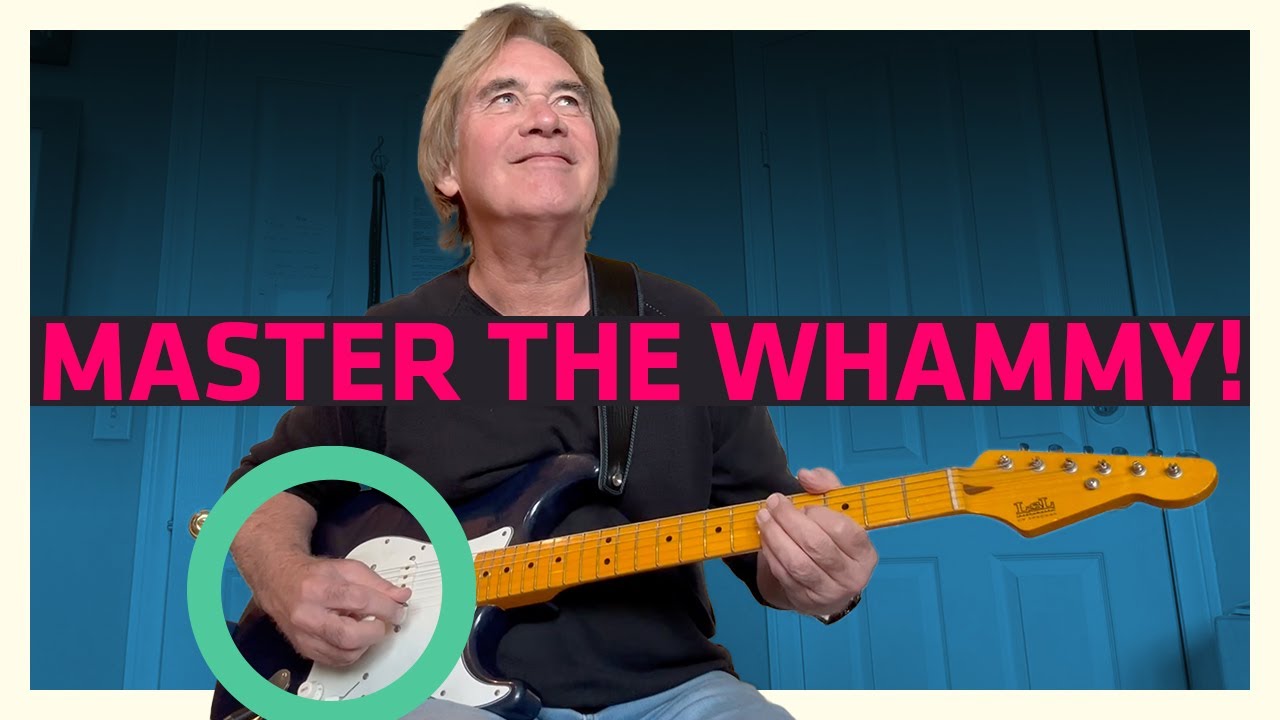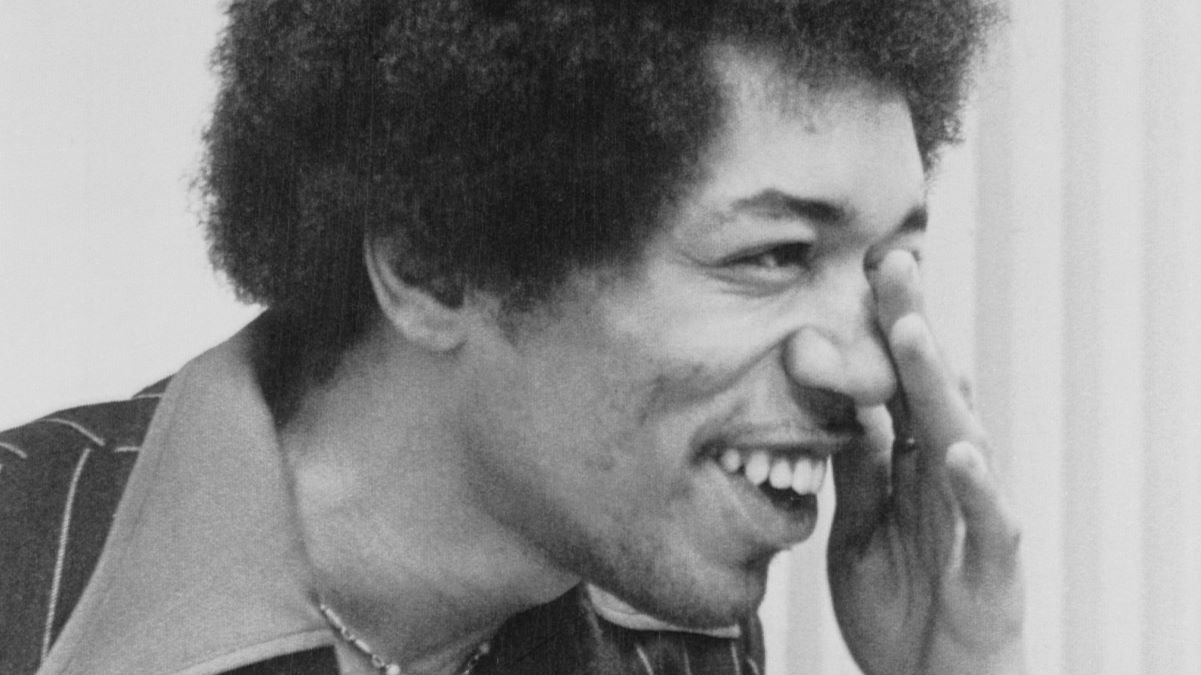
You might think that the vast majority of rock riffs are in minor keys, but not so! A close study of the rock and pop guitar repertoire over the decades discloses a multitude of major tonality-based riffs.
The major scale and its close relative, the Lydian mode, are terrific sources for creating captivating and mostly bright-sounding riffs that can evoke all sorts of emotions, ranging from love, elation and triumph to mystery and even melancholy.
In this lesson, we’ll explore, arrange and deconstruct various riffs based on both the major scale and the Lydian mode.
Ionian (Major-Scale) Riffs
Throughout this lesson, the major scale will be referenced by its modal name, Ionian. As such, the C major scale (C D E F G A B) can also be called the C Ionian mode.
1950s – ‘70s
First up is a rollicking riff inspired by “La Bamba,” the smash hit by 1950s rock and roll star Ritchie Valens (Ex. 1).

The riff is based on the chord tones of the I-IV-V progression (C-F-G7) and hits every note of C Ionian. An early example of a bona fide guitar riff, it undoubtedly influenced future guitarists and riff writers. You’ll hear echoes of the original in later hits such as Roy Orbison’s “Pretty Woman.”

Ex. 2 is based on “Funk Brother” Robert White’s iconic intro to the Temptations’ classic Motown hit “My Girl.” Also in C Ionian, the melody cruises along the structure of the C-to-F chord cycle courtesy of C major pentatonic (C D E G A) and F major pentatonic (F G A C D) phrases. (Both of these five-note scales are diatonic to C Ionian, containing common notes.)
In this example, the major seventh, B, is thrown in to sweeten the pot. To achieve the desired tone, pick the strings with your thumb, using a strong attack.

Ex. 3 demonstrates how the sweet R&B stylings of the 1950s and early ’60s were transformed in classic rock. Equal parts Jimi Hendrix (“Angel,” “May This Be Love” and “The Wind Cries Mary”) and the Beatles (“Sun King” and “Don’t Let Me Down”), this riff in E Ionian (E F# G# A B C# D#) is fortified with sliding-fourths intervals and hammer/pull dyads that are scattered across the fretboard. This style, which pays homage to R&B pioneers like Curtis Mayfield, Cornell Dupree and others, is challenging to master.

Although it’s not generally recognized as a guitar riff per se (multiple instruments double the line on the original recording), the intro to Brian Wilson’s “California Girls” – a 1965 hit for the Beach Boys – signifies a shining moment in the ’60s Ionian repertoire. The offset rhythm of the melodic passage alone is worth the price of admission. Cast from B Ionian (B C# D# E F# G# A# ), Ex. 4 is a subtle reimagining of this classic riff, embellished with a bluesy half-step bend.

Jumping ahead to the ’70s, Ex. 5 is a twangy, folk-rock riff inspired by Mike Campbell’s 12-string rhythm work in “Listen to Her Heart” by Tom Petty & the Heartbreakers. Drawing from the groundbreaking 12-string riffs of the ’60s as crafted by such players as the Byrds’ Roger McGuinn and the Beatles’ George Harrison, it’s primarily chordal, outlining A, Asus4 and Asus2, all of which live within the A Ionian mode (A B C# E D E F# G#). It kicks up a notch in bar 2 with a driving single-note bass line played on the A string.

Ex. 6 epitomizes Eric Clapton’s mid-1970s blues guitar pop stylings. G Ionian (G A B C D E F#) by nature, it’s an amalgamation of his main riff lines in “Wonderful Tonight.” Voiced high on the neck for ease of bending (Clapton played most of the riff in seventh position), the melody avoids the major seventh degree (F#), relying chiefly on G major pentatonic note choices (G A B D E), with an added C note in the conclusion of the phrase.

Paul McCartney and Wings’ smash 1974 hit “Band on the Run” may hold the record for the longest guitar introduction comprised entirely of fourths dyads. (Nile Rodgers’ riff that kicks off David Bowie’s “China Girl” would come in a close second.) Ex. 7 serves up a slice of the aforementioned iconic intro, then caps it off with a pair of inverted Em and F# m triads.

Let’s close out our ’70s segment with a riff so infectious, the composer felt the need to transpose it to five different keys over the course of the arrangement! We’re talking about John “Cougar” Mellencamp’s late-’70s hit, “I Need a Lover.” Ex. 8 offers a variation on the riff in an E Ionian setting. As a musical exercise, you may want to try your hand at transposing the phrase to other keys. Staying true to the original song, try to hit the keys of A, Bb, B and F#.
1980s and Beyond
The dawn of the 1980s ushered in the era of MTV and jangly-riff songs built around open chords. Cashing in big time on both trends, the unstoppable Rolling Stones hit the decade running with “Waiting on a Friend.”
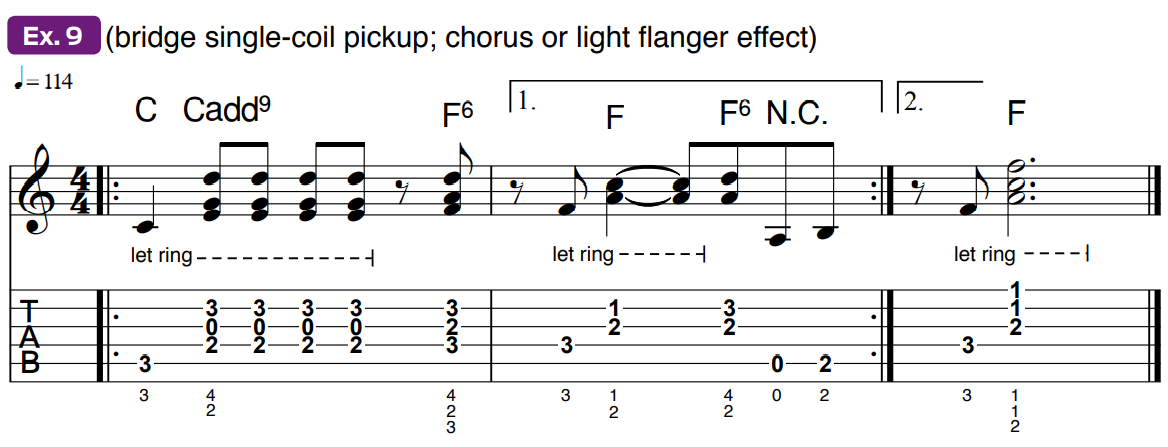
Not only does the main riff jangle in a way similar to Ex. 9, the song also produced one of the most popular MTV videos of that time period. Be sure to throw on a chorus pedal or a touch of light flanging to up the sparkle factor on this C Lydian riff.

Journey are another group that benefited in a big way from the onslaught of the fledgling MTV network. Ex. 10 blends elements from two of the group’s most popular major-mode-based songs, “Any Way You Want It” and “Don’t Stop Believin’,” into an E Ionian single-note riff enhanced with bold finger vibrato (a signature element of lead guitarist Neal Schon’s style) and chords.
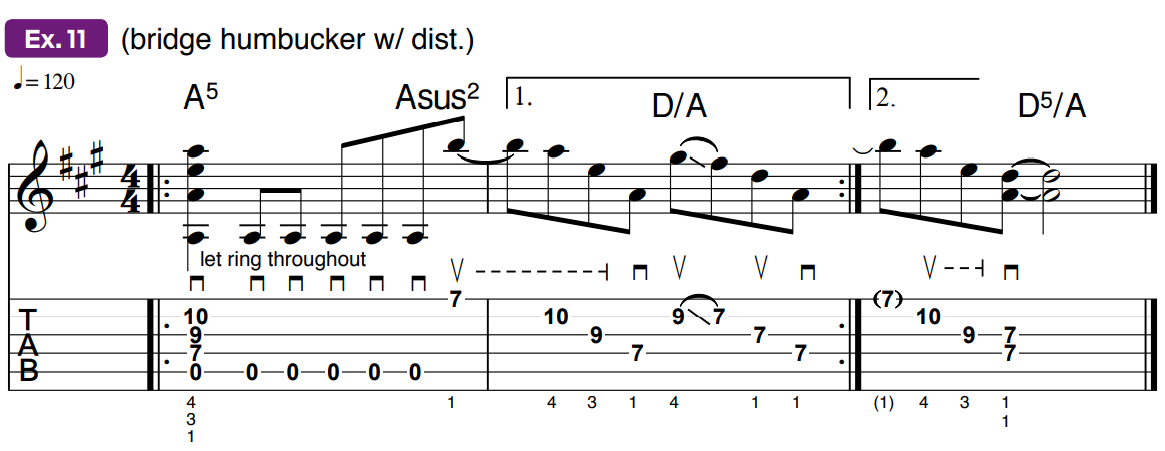
You probably wouldn’t associate AC/ DC with the Ionian mode, yet there it is, firmly ensconced in the chord/melody-style intro to “You Shook Me All Night Long.” Granted, Angus Young throws in a couple of chromatic passing tones, but he makes liberal use of the G Ionian mode, including the major seventh. Ex. 11 reimagines the original riff in the key of A Ionian, mainly so that the open A string can fortify the key center. Keep your index finger barred across the top four strings throughout the entire passage.

Few guitarists, or musicians for that matter, have as sensitive a touch as Jeff Beck, who is revered for his ability to interpret a melody in a variety of emotive ways. The intro to his 1985 hit cover of Curtis Mayfield’s “People Get Ready” (originally recorded by the Impressions in 1965) exposes the fingerstyle electric guitarist’s uncanny chord-melody instincts. His lead fills that complement Rod Stewart’s vocal phrases throughout the song are downright stunning, but the intro riff is a definite standout.
Ex. 12 offers a similarly styled phrase based on the D Ionian mode (D E F# G A B C#) and meant to be performed fingerstyle, much as one would on a classical acoustic guitar. Play this passage with a lot of expression and dynamics.

Ex. 13 is a lovely acoustic example that springs from another rather unexpected source, namely Zakk Wylde. Inspired by the burly guitarist’s cascading intro riff to Ozzy Ozbourne’s 1992 hit single “Mama, I’m Coming Home,” it’s an E Ionian–based melody that similarly descends the G string and is interwoven with open B and high E notes. The original figure walks straight down the scale, but this derivative phrase mixes in a dash of George Harrison’s down-up-down melodic contour from the early Beatles hit “Please Please Me.”

Texas-born guitar virtuoso Eric Johnson has been at the forefront of modern high-tech electric guitar for the past three decades. Ex. 14 pays tribute to the Lone-Star Tone Czar with an arpeggio-laced example crafted from C Ionian. You’ll hear Johnson play similarly styled lines in his Ionian-based tour de force, “Cliffs of Dover.”
Lydian Riffs
Everyone knows what it feels like when they don’t get enough sleep the night before. Things seem just a little bit “off.” In a way, that’s what the Lydian mode is like when compared to Ionian. While the two scales are almost identical in structure, Lydian has a raised fourth degree (C Ionian: C D E F G A B; C Lydian: C D E F# G A B).
Subtle but significant, the raised fourth degree gives the Lydian mode a dreamlike, mysterious and wistful quality. Perhaps that’s why many film score composers use it in scenes of childhood innocence, dream sequences and reflection. (Check out the soundtrack to the 1962 film To Kill a Mockingbird.)
Let’s now explore some guitar riffs and musical passages that employ this emotion-evoking mode.

Based on the A Lydian mode (A B C# D# E F# G#), Ex. 15 illustrates a common occurrence in Lydian progressions – the establishment of a I major chord (in this case, A) coupled with a II major (B) and often fueled with a droning tonic pedal tone, in this case provided by the open fifth string. Essentially a loose composite of Mike Campbell and Tom Petty’s guitar figures in “Here Comes My Girl,” the passage casts an anticipatory mood, as they did in support of Petty’s spoken verses.
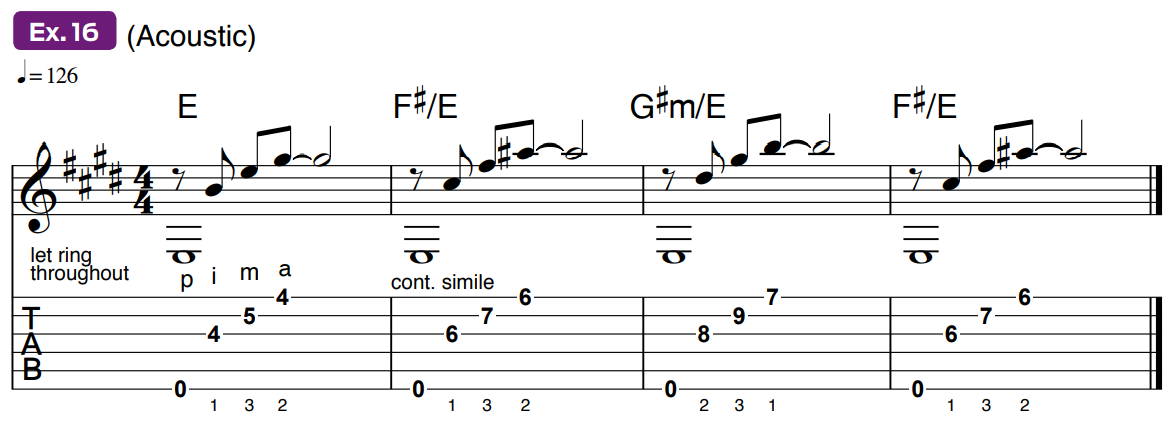
Ex. 16 is inspired by Fleetwood Mac guitarist Lindsey Buckingham’s acoustic intro to Stevie Nick’s song “Sara.” Harmonized from E Lydian (E F# G# A# B C# D#), it’s also set against a tonic drone (in this case, the open low E string) and is driven by a I-II (E-F#) chord sequence. Also included is an arpeggiated G# m chord (G# -B-D#), which is the iii chord in E Lydian. Notice how the passage evokes a wistful, melancholy mood that befits the lyrics of the song itself.

Ex. 17 brings to mind the rhythm riffs in Joe Satriani’s Lydian showcase, “Flying in a Blue Dream.” (Satch had employed an alternate tuning on the original recording, while this example is presented in standard tuning.) The first two bars are in F Lydian (F G A B C D E). The Fsus2(add#11) chord suggests a partial G triad over an F bass note that gives way to an F major chord, thus establishing the toggling I-II chord sequence (albeit backward this time) that we’ve discussed.
Bars 3 and 4 modulate directly to C Lydian, where once again the chords suggest a I-II trade-off, here in the new key. In Satriani’s original composition, the creative guitarist improvises corresponding Lydian melodies over each new set of chord changes: C Lydian over the C chord types, F Lydian over the F chords, Ab Lydian over the Ab chords and G Lydian over the G chords.
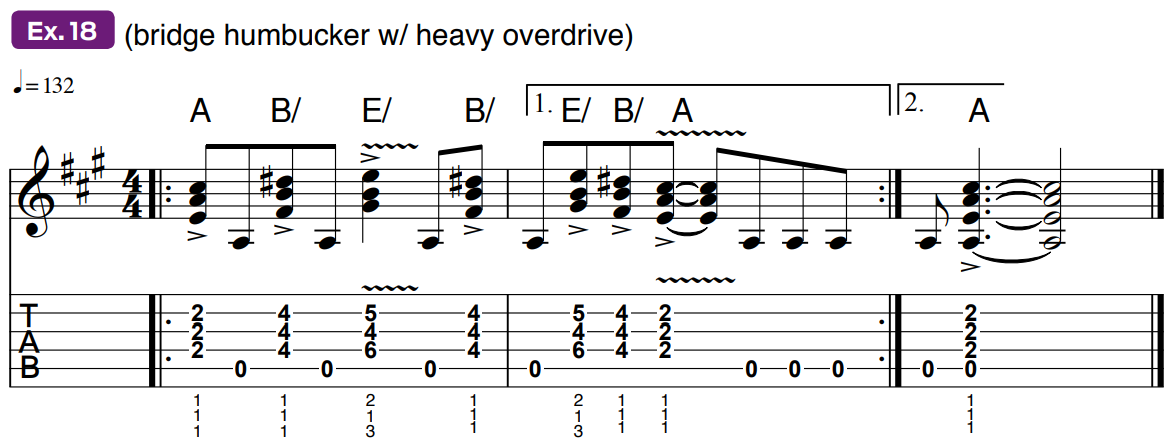
Ex. 18 is inspired by one of several Lydian passages in Journey’s arena rocker “Escape.” Based on A Lydian, it also features a driving tonic pedal tone that reinforces the ubiquitous I-II chord sequence (A-B). This example also includes a V-chord triad (E is the V chord in A Lydian). Strive to “wiggle” the marked triads with aggressive finger vibrato. Don’t be afraid to shake the guitar neck.

The octave-doubled melody line in Ex. 19 recalls the distinct E Lydian-based interlude in the Who’s “Who Are You.” Be careful to mute the unused string that lies between the two notes of each fretted octave. This is effectively accomplished by using the fleshy underside of your fret-hand index finger to mute the B string in the first four shapes and the G string on the remaining ones.

Based on A Lydian, Ex. 20 is inspired by Joe Walsh’s hypnotic intro to “Theme from Boat Weirdos,” an instrumental track from his 1978 hit album, But Seriously, Folks… Walsh is a master of crafty guitar figures, wherein the use of strategically placed open strings facilitates the performance of unusual chord voicings that would otherwise be unplayable using fretted notes alone. The picking pattern is the key to unlocking the melodic puzzle here and offers a creative springboard for devising similarly styled creations of your own.

Ex. 21 is the shortest and perhaps most straight-ahead offering in this lesson so far. An endlessly cycled riff cast from C Lydian, it brings to mind XTC’s 1989 hit single “Mayor of Simpleton.” The riff’s quirky charm is mainly due to the ringing open-G string, a technique used to great effect in Blue Öyster Cult’s similarly styled minor-key riff for “(Don’t Fear) the Reaper.”
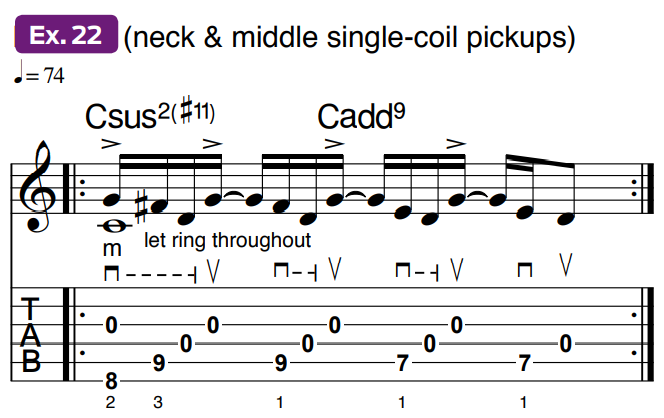
Ex. 22 is also in C Lydian and is a rearrangement of the intro and outro passages of Christopher Cross’s yacht-rock smash hit, “Sailing.” Cross had employed an alternate tuning for that song, which is in the key of D, but this arrangement and new key make for similarly haunting riff that’s playable in standard tuning.

Ex. 23 is in the style of Police guitarist Andy Summers. Essentially a composite of the bubbling piano and synthesizer parts heard on the verses of “Every Little Thing She Does Is Magic” (which cycles around the G Lydian mode: G A B C# D E F#), it’s highly representative of the unique parts that the ground-breaking guitarist played during his tenure in the iconic band.

Ex. 24 heralds the Lydian mode’s “Big ’80s!” style. Inspired by the way-huge synth intro to Tears for Fears’ “Head Over Heels,” it drops straight down the C Lydian mode in bars 1 and 2. Bars 3 and 4 are inspired by the “answering” guitar line heard on the original recording.

Our final example, Ex. 25, is a fun mash-up that’s equal parts Jimmy Page (inspired by his playing on “Over the Hills and Far Away” and “Dancing Days”) and Steve Howe (recalling his solo break in “Sound Chaser”). An open-position, G-Lydian extravaganza, it makes good use of the technique of using single and double hammer-ons and pull-offs in various combinations with open strings, something for which innovative and exciting guitarists are known.
Get The Pick Newsletter
All the latest guitar news, interviews, lessons, reviews, deals and more, direct to your inbox!
“Write for five minutes a day. I mean, who can’t manage that?” Mike Stern's top five guitar tips include one simple fix to help you develop your personal guitar style
"It’s like you’re making a statement. And you never know where it’ll lead." Pete Thorn shares the tip that convinced Joe Satriani he was the right guitarist for the SatchVai Band




